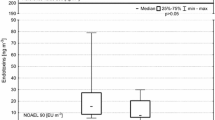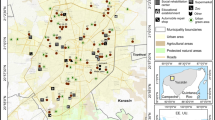Abstract
In this study, air samples were taken using a BioSampler and gelatin filters from six sites in Beijing: office, hospital, student dormitory, train station, subway, and a commercial street. Dust samples were also collected using a surface sampler from the same environments. Limulus amoebocyte lysate (LAL) and Glucatell assays were used to quantify sample endotoxin and (1,3)-\({\rm{\beta}} \)-d-glucan concentration levels, respectively. Enzyme-linked immunosorbent assay (ELISA) was used to measure the dust mite allergens (Der p 1 and Der f 1). Ultrafine particle and lead concentrations in these sampling sites were also measured using P-Trak and atomic absorption spectrometer, respectively. Analysis of variance (ANOVA) and linear regression analysis were used to analyze the concentration data. Higher culturable bacteria (12,639 CFU/m3) and fungi (1,806 CFU/m3) concentrations were observed for the train station and the subway system, respectively. For the rest of sampling sites, their concentrations were comparable to those found in western countries, ranging from 990 to 2,276 CFU/m3 for bacteria, and from 119 to 269 CFU/m3 for fungi. ANOVA analysis indicated that there were statistically significant differences between the culturable bacterial and fungal concentration levels obtained for different sites (p value = 0.0001 and 0.0047). As for dust allergens, endotoxin, and (1,3)-β -d-glucan, their concentrations also seemed to be comparable to those found in the developed countries. Airborne allergen concentrations ranged from 16 to 68 ng/m3. The dust-borne allergen concentration was observed to range from 0.063 to 0.327 ng/mg. As for endotoxin, the highest airborne concentration of 25.24 ng/m3 was observed for the commercial street, and others ranged from 0.0427 to 0.1259 ng/m3. And dust-borne endotoxin concentration ranged from 58.83 to 6,427.4 ng/mg. For (1,3)-β -d-glucan, the airborne concentration ranged from 0.02 to 1.2 ng/m3. Linear regression analyses showed that there existed poor correlations between those in airborne and dust-borne states (R2 = 0.002~0.43). In our study, the lowest ultrafine particle concentration about 5,203 pt/cm3 was observed in office and the highest was observed at the train station, up to 32,783 pt/cm3. Lead concentration was shown to range from 80 to 170 ng/mg with the highest also observed at the train station. The information provided in this work can be used to learn the general situation of relevant health risks in Beijing. And the results here suggested that when characterizing exposure both airborne and dust-borne as well as the environments should be considered.
Similar content being viewed by others
References
Araujo, J. A., Barajas, B., Kleinman, M., Wang, X., Bennett, B. J., Gong, K. W., et al. (2008). Ambient particulate pollutants in the ultrafine range promote early atherosclerosis and systemic oxidative stress. Journal of Circulation Research, 102, 589–596.
Beckerman, B., Jerrett, M., Brook, J. R., Verma, D. K., Arain, M. A., & Finkelstein, M. M. (2008). Correlation of nitrogen dioxide with other traffic pollutants near a major expressway. Atmospheric Environment, 42, 275–290.
Czop, J. K., & Kay, J. (1991). Isolation and characterization of β-glucan receptors on human mononuclear phagocytes. Journal of Experimental Medicine, 73, 1511–1520.
Dales, R., Miller, D., Ruest, K., Guay, M., & Judek, S. (2006). Airborne endotoxin is associated with respiratory illness in the first 2 years of life. Environmental Health Perspectives, 114, 610–614.
Dekoster, J. A., & Thorne, P. S. (1995). Bioaerosol concentrations in noncomplaint, complaint, and intervention homes in the Midwest. American Industrial Hygiene Association Journal, 56, 573–580.
Delfino, R. J., Sioutas, C., & Malik, S. (2005). Potential role of ultrafine particles in associations between airborne particle mass and cardiovascular health. Environmental Health Perspectives, 113, 934–946.
Donaldson, K., Li, X. Y., & MacNee, W. (1998). Ultrafine (nanometre) particle mediated lung injury. Journal of Aerosol Science, 29, 553–560
Douwes, J., Versloot, P., Hollander, A., Heederik, D., & Doekes, G. (1995). Influence of various dust sampling and extraction methods on the measurement of airborne endotoxin. Applied and Environmental Microbiology, 61, 1763–1769.
Douwes, J., Thorne, P., Pearce, N., & Heederik, D. (2003). Review: Bioaerosol health effects and exposure assessment: Progress and prospects. Annals of Occupational Hygiene, 47, 187–200.
Foto, M., Vrijmoed, L. L., Miller, J. D., Ruest, K., Lawton, M., & Dales, R. E. (2005). A comparison of airborne ergosterol, glucan and Air-O-Cell data in relation to physical assessments of mold damage and some other parameters. Indoor Air, 15, 257–266.
Fung, F., & Hughson, W. G. (2003). Health effects of indoor fungal bioaerosol exposure. Applied Occupational and Environmental Hygiene, 18, 535–544.
Green, C. F., & Scarpino, P. V. (2002). The use of ultraviolet germicidal irradiation (UVGI) in disinfection of airborne bacteria. Environmental Engineering and Policy, 3, 101–107.
Hosobuchi, K., & Tanamoto, K. (1998). Inactivation of endotoxin by gamma irradiation. Bulletin of Tokyo Metropolitan Industrial Technology Research Institute, 1, 113–116.
Lavoie, J., & Dunkerley, C. J. (2002). Assessing waste collectors’ exposure to bioaerosols. Aerobiologia, 18, 277–285.
Lee, S. Y., Choi, J., Han, K., & Song, J. Y. (1999). Removal of endotoxin during purification of Poly(3-Hydroxybutyrate) from Gram-negative bacteria. Applied and Environmental Microbiology, 65, 2762–2764.
Lighthart, B. (1997). The ecology of bacteria in the alfresco atmosphere. FEMS Microbiology Ecology, 23, 263–274.
Limbach, L. K., Wick, P., Manser, P., Grass, R. N., Bruinink, A., & Stark, W. J. (2007). Exposure of engineered nanoparticles to human lung epithelial cells: Influence of chemical composition and catalytic activity on oxidative stress. Environmental Science and Technology, 41, 4158–4163.
Matson, U. (2005). Indoor and outdoor concentrations of ultrafine particles in some Scandinavian rural and urban areas. Science of the Total Environment, 343, 169–176.
National Research Council (2002). The airliner cabin environment and the health of passengers and crew committee on air quality in passenger cabins of commercial aircraft. Washington: National Academy.
Nielsen, B. H., Nielsen, E. M., & Breum, N. O. (2000). Seasonal variation in bioaerosol exposure during biowaste collection and measurements of leaked percolate. Waste Management and Research, 18, 64–72.
Paez-Rubio, T., & Peccia, J. (2004). Estimating solar inactivation rates of airborne bacteria. Journal of Environmental Engineering, 131, 512–517.
Platts-Mills, T. A. E., & de Weck, A. L. (1989). Dust mite allergens and asthma—A world wide problem. Journal of Allergy and Clinical Immunology, 83, 416–427.
Proud, D., Bailey, G. S., Naclerio, R. M., Reynolds, C. J., Cruz, A. A., Eggleston, P. A., et al. (1992). Tryptase and histamine as markers to evaluate mast-cell activation during the responses to nasal challenge with allergen, cold, dry, air, and hyperosmolar solutions. Journal of Allergy and Clinical Immunology, 89, 1098–1110.
Puustinnen, A., Hameri, K., Pekkanen, J., Kulmala, M., de Hartog, J., Meliefste, K., et al. (2007). Spatial variation of particle number and mass over four European cities. Atmospheric Environment, 41, 6622–6636.
Rao, C. Y., Riggs, M. A., Chew, G. L., Muilenberg, M. L., Thorne, P. S., Van Sickle, D., et al. (2007). Characterization of airborne molds, endotoxins, and glucans in homes in New Orleans after Hurricanes Katrina and Rita. Applied and Environmental Microbiology, 73, 1630–1634.
Reynolds, S. J., Milton, D. K., Heederik, D., Thorne, P. S., Donham, K. J., Croteau, E. A., et al. (2005). Interlaboratory evaluation of endotoxin analyses in agricultural dusts—Comparison of LAL assay and mass spectrometry. Journal of Environmental Monitoring, 7, 1371–7137.
Robbins, C. A., Swenson, L. J., Nealley, M. L., Gots, R. E., & Kelman, B. J. (2000). Health effects of mycotoxins in indoor air: A critical review. Applied Occupational and Environmental Hygiene, 15, 773–784.
Ross, M. A., Curtis, L., Scheff, P. A., Hryhorczuk, D. O., Ramakrishnan, V., Wadden, R. A., et al. (2000). Association of asthma symptoms and severity with indoor bioaerosols. Allergy, 55, 705–711.
Rylander, R. (1997). Endotoxins in the environment—A criteria document. International Journal of Occupational and Environmental Health, 3, S1–S48.
Rylander, R. (2005). (1→3)-β -D-glucan in the environment: A risk assessment. In S.-H. Young & V. Castranova (Eds.), Toxicology of (1→3)-β -D-glucans (pp. 53–64). Boca Raton: Taylor & Francis.
Sanborn, M. D., Abelsohn, A., Campbell, M., & Weir, E. (2002). Identifying and managing adverse environmental health effects: 3. Lead exposure. Canadian Medical Association Journal, 166, 1287–1292.
Shi, J. P., Evans, D. E., Khan, A. A., & Harrison, R. H. (2001). Sources and concentrations of nanoparticles (<10 nm diameter) in the urban atmosphere. Atmospheric Environment, 35, 1193–1202.
Sichela, C., de Carab, M., Tellob, J., Blancoa, J., & Fernández-Ibáñez, P. (2007). Solar photocatalytic disinfection of agricultural pathogenic fungi: Fusarium species. Applied Catalysis B: Environmental, 74, 152–160.
Sigsgaard, T., Bach, B., & Malmros, P. (1990). Respiratory impairment among workers in a garbage handling plant. American Journal of Industrial Medicine, 17, 92–93.
Sioutas, C., Delfino, R. J., & Singh, M. (2005). Exposure assessment for atmospheric ultrafine particles (UFPs) and implications in epidemiological research. Environmental Health Perspectives, 113, 947–955.
Spengler, J., Burge, H., Dumyahn, T., Muilenberg, M., & Forester, D. (1997). Environmental survey on aircraft and ground-based commercial transportation vehicles. Prepared for the Commercial Airplane Group, The Boeing Company, by Harvard School of Public Health, Harvard University, Cambridge, MA.
Sporik, R., Ingram, J. M., Price, W., Sussman, J. H., Honsinger, R. W., & Platts-mills, T. A. E. (1995). Association of asthma with serum IgE and skin test reactivity to allergens among children living at high altitude. American Journal of Respiratory and Critical Care Medicine, 151, 1388–1392.
Surdu, S., Montoya, L. D., Tarbell, A., & Carpenter, D. O. (2006). Childhood asthma and indoor allergens in Native Americans in New York. Environmental Health: A Global Access Science Source, 5, 22.
Thomas, V. M., Socolow, R. H., Fanelli, J. J., & Spiro, T. G. (1999). Effects of reducing lead in gasoline: An analysis of the international experience. Environmental Science and Technology, 33, 3942–3948.
Thorn, J., & Rylander, R. (1998). Airways Inflammation and Glucan in a Rowhouse area. American Journal of Respiratory and Critical Care Medicine, 157, 1798–1803.
Thorn, J., Beijer, L., & Rylander, R. (1998). Airways inflammation and glucan exposure among household waste collectors. American Journal of Industrial Medicine, 33, 463–470.
Thorne, P. S. (2000). Inhalation toxicology models of endotoxin- and bioaerosol-induced inflammation. Toxicology, 152, 13–23.
Toivola, M., Nevalainen, A., & Alm, S. (2004). Personal exposures to particles and microbes in relation to microenvironmental concentrations. Indoor Air, 14, 351–359.
Tolocka, M. P., Lake, D. A., Johnston, M. V., & Wexler, A. S. (2004). Number concentrations of fine and ultrafine particles containing metals. Atmospheric Environment, 38, 3263–3273.
Tolvanen, O. K., & Hanninen, K. I. (2005). Occupational hygiene in a waste incineration plant. Waste Management, 25, 519–529.
Tong, Y., & Lighthart, B. (1997). Solar radiation has a lethal effect on natural populations of culturable outdoor atmospheric bacteria. Atmospheric Environment, 31, 897–900.
Yao, M., Zhu, T., Li, K., Dong, S., Wu, Y., Qiu, X., et al. (2009). Onsite infectious agents and toxins monitoring in 12 May Sichuan earthquake affected areas. Journal of Environmental Monitoring. doi:10.1039/b910243d.
Author information
Authors and Affiliations
Corresponding author
Rights and permissions
About this article
Cite this article
Dong, S., Yao, M. Exposure assessment in Beijing, China: biological agents, ultrafine particles, and lead. Environ Monit Assess 170, 331–343 (2010). https://doi.org/10.1007/s10661-009-1236-7
Received:
Accepted:
Published:
Issue Date:
DOI: https://doi.org/10.1007/s10661-009-1236-7




